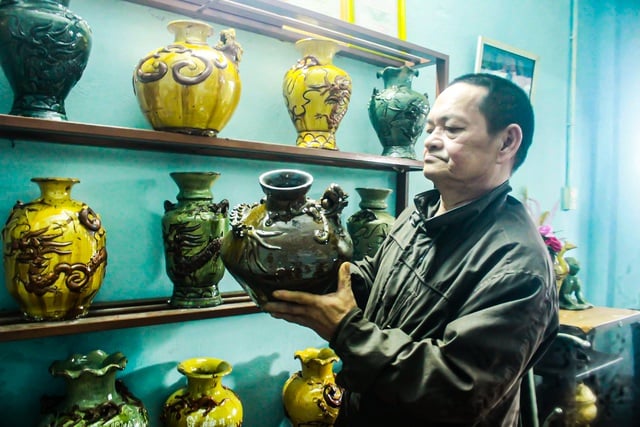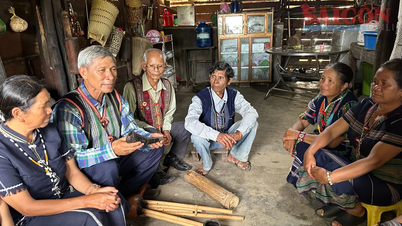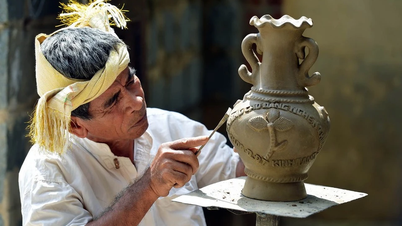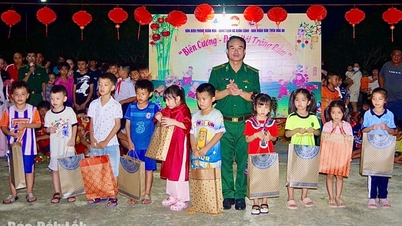This is not only a recognition of the value of a craft village over 200 years old, but also a wake-up call for the pride and aspiration to restore the quintessence of terracotta of the land along the Tra Bong River.
Tra Bong River passes through My Thien pottery village in Binh Son commune, Quang Ngai . PHOTO: HAI PHONG
Located on the left bank of Tra Bong River, My Thien pottery village in Binh Son commune, Quang Ngai (formerly Chau O town, Binh Son district, Quang Ngai) was formed in the early 19th century.
Mr. Le Hong Khanh, a cultural researcher in Quang Ngai, said that according to some funeral oration documents and folklore, more than 200 years ago, Mr. Pham Cong Dac and Mr. Nguyen Cong At from Thanh Hoa and their families settled in Quang Ngai, built the first kilns and opened My Thien pottery village. This is one of many prosperous pottery villages at that time, recorded in the petition of Quang Ngai Governor Nguyen Ba Trac to King Bao Dai and later published in the famous Nam Phong magazine in 1933.
In the early 1980s, My Thien pottery entered a period of strong development. The whole village had dozens of handmade pottery kilns specializing in producing household items such as earthen pots, cups, bowls, vases, jars, etc. with skillful turntable techniques. In 1982, My Thien pottery cooperative was established, gathering more than 200 members, bustling production activities day and night to supply goods to the Central and Central Highlands regions.
My Thien pottery has its own unique characteristics. The main raw material is clay mined locally, left outdoors in the sun and rain for 12 months to remove minerals, then mixed and created into molds. The talented hands of artisans on traditional turntables skillfully knead and shape each product, then decorate with simple but creative tools. After being shaped, the products are dried for 10 - 20 days, then continuously fired in the kiln for 72 hours, then continued to be heated for another 72 hours before leaving the factory.
REVIVING CRAFT VILLAGES
Thanks to the elaborate process, combining human hands and the rigor of fire, My Thien ceramic products are durable, retain heat well, and are safe for users' health. However, the competitiveness of traditional ceramics could not withstand the influx of cheap plastic and porcelain products from China in the late 1990s. The market gradually turned its back, the kilns stopped firing, the ceramic cooperatives dissolved, and the whole craft village fell into dire straits.
Mr. Dang Van Trinh looks at the products he made. PHOTO: NGUYEN TRANG
Many families who make traditional pottery have been forced to abandon their craft and turn to farming, trading, or working for hire. As the craft village is on the brink of extinction, only a few households still maintain their kilns, including artisan Dang Van Trinh (60 years old), a fourth-generation craftsman in a family with a long tradition of making pottery in My Thien.
"Making pottery is a profession of patience and passion. From choosing the soil to shaping and firing the kiln, there is no easy step. But potters love the fire, the soil, and the meticulousness and silence of the profession. I just hope that today's young generation will have someone to keep this profession alive, but it seems that now only Ngo Dao Giang is left as a young person following the profession," Mr. Trinh confided.
Recently (June 27, 2025), when the Ministry of Culture, Sports and Tourism announced My Thien pottery as a national intangible cultural heritage, it brought good news to the pottery makers here, especially Mr. Dang Van Trinh's family. This is not only a recognition from the state but also an opportunity to restore, preserve and develop this traditional pottery village.
Over the past two centuries, the land has tempered the craft, the fire has forged the soul. My Thien pottery is not only a simple handmade product, but also a living heritage that bears the mark of the hands, minds and souls of many generations of people along the Tra Bong River.
On July 7, the People's Committee of Binh Son commune said that the locality is coordinating with the Department of Culture, Sports and Tourism of Quang Ngai province to develop a project to restore ancient pottery kilns, organize vocational training classes for the younger generation, and find ways to consume products through experiential tourism . Artisans like Mr. Dang Van Trinh will play a key role in passing on the profession and preserving traditional techniques.
Source: https://thanhnien.vn/hoi-sinh-lang-gom-hon-200-nam-tuoi-ben-song-tra-bong-185250708222943851.htm







![[Photo] Prime Minister Pham Minh Chinh chairs meeting to deploy overcoming consequences of storm No. 10](https://vphoto.vietnam.vn/thumb/1200x675/vietnam/resource/IMAGE/2025/10/3/544f420dcc844463898fcbef46247d16)
![[Photo] Students of Binh Minh Primary School enjoy the full moon festival, receiving the joys of childhood](https://vphoto.vietnam.vn/thumb/1200x675/vietnam/resource/IMAGE/2025/10/3/8cf8abef22fe4471be400a818912cb85)





























































































Comment (0)